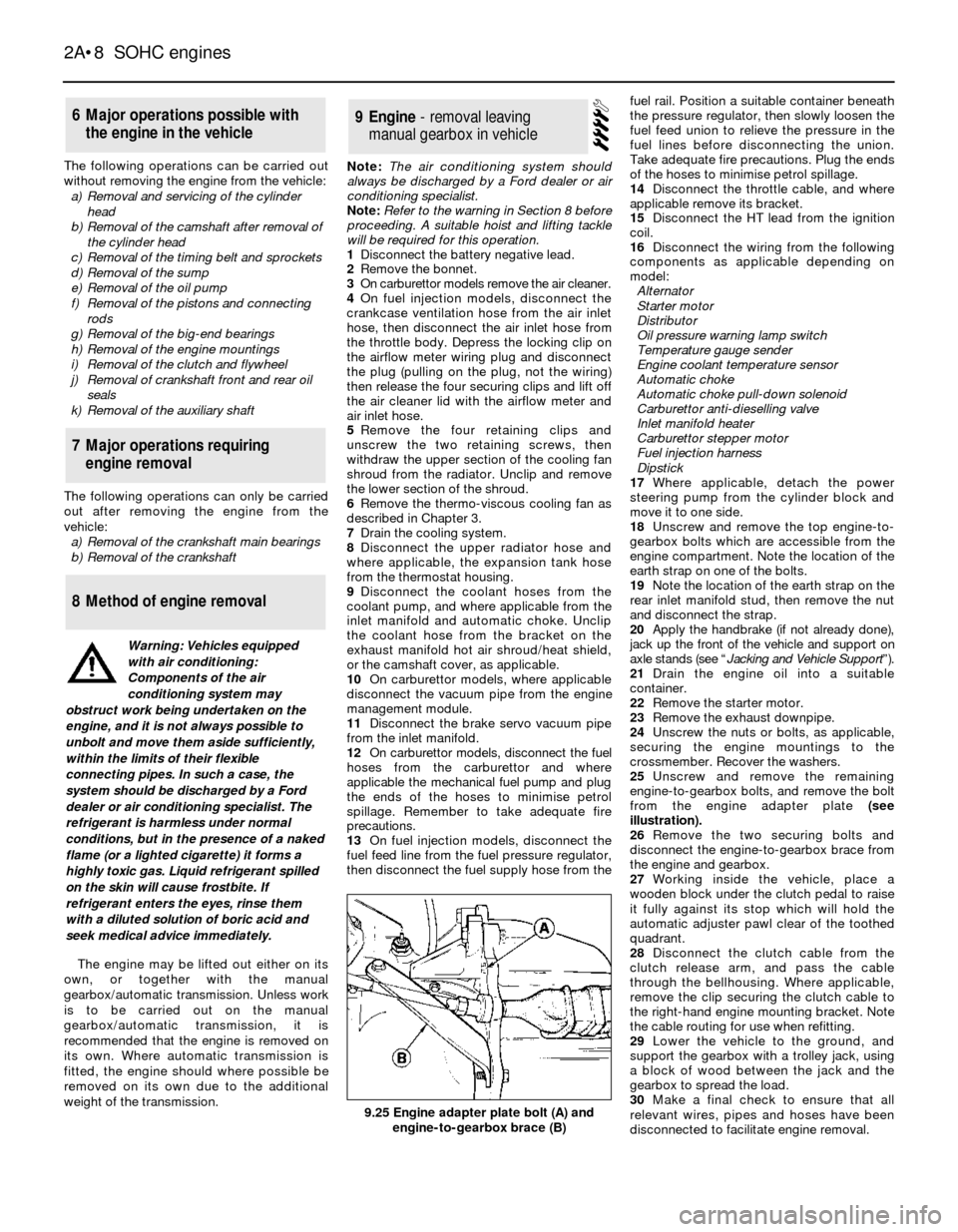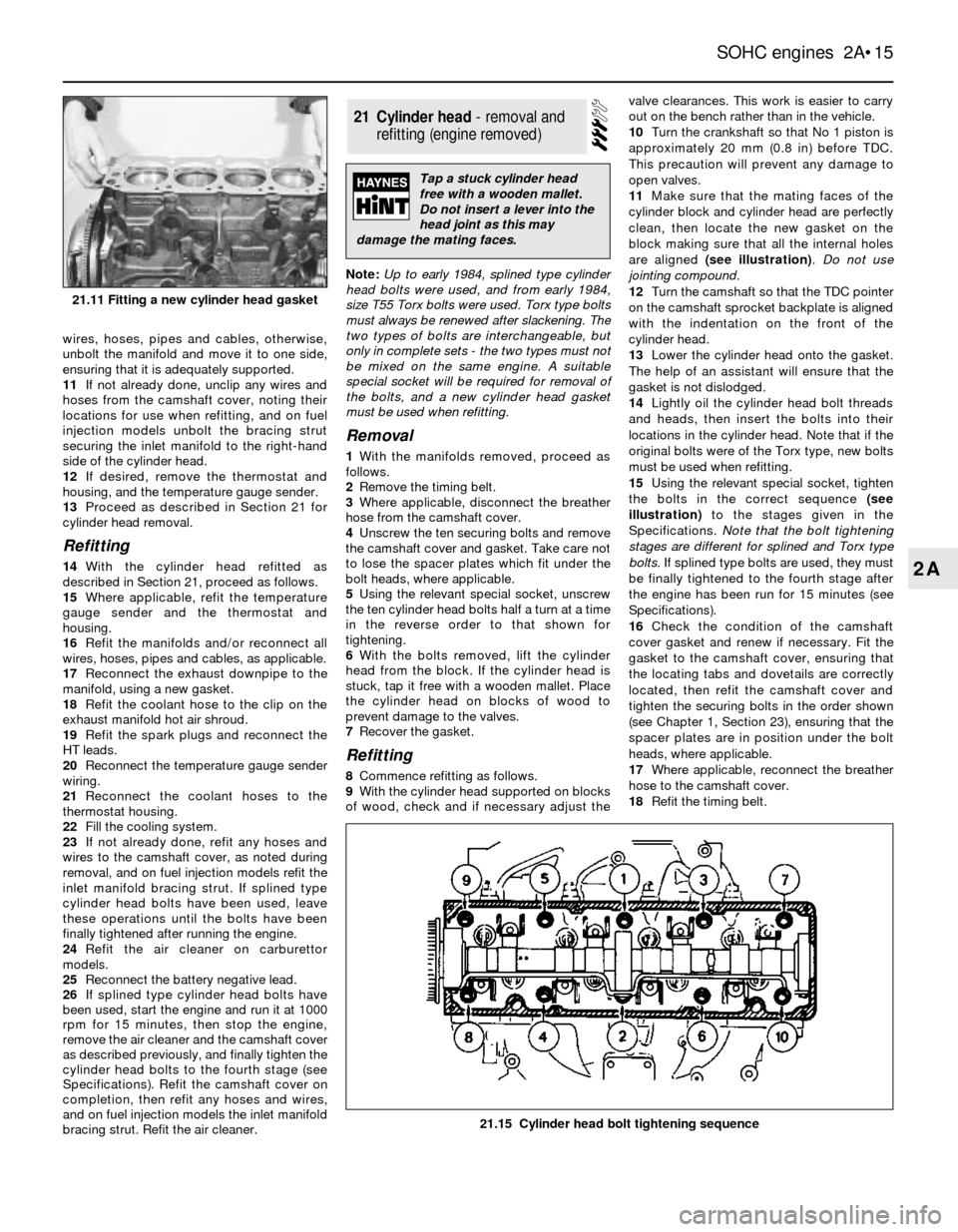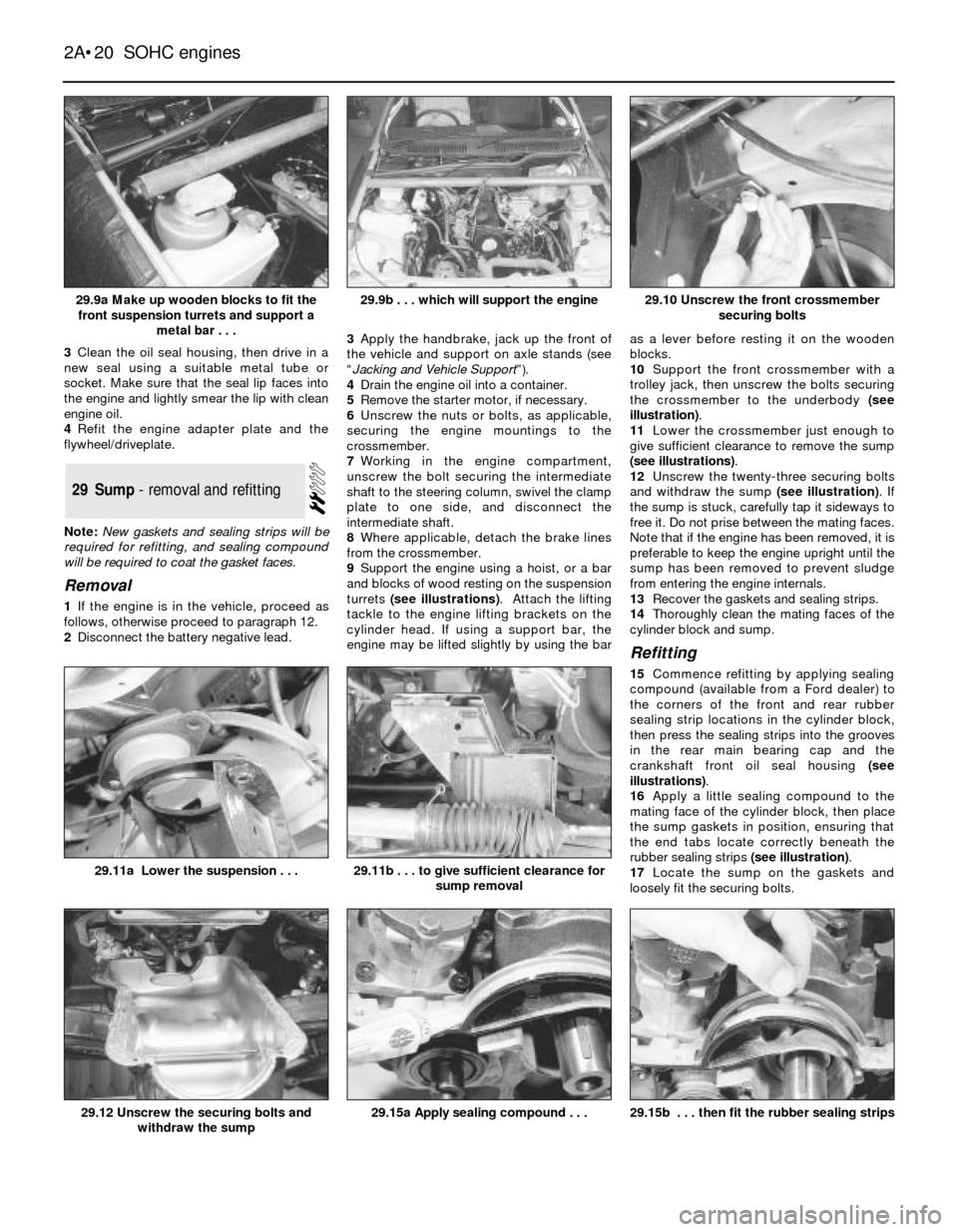battery location FORD SIERRA 1982 1.G SOHC Engines Workshop Manual
[x] Cancel search | Manufacturer: FORD, Model Year: 1982, Model line: SIERRA, Model: FORD SIERRA 1982 1.GPages: 24, PDF Size: 1.03 MB
Page 8 of 24

The following operations can be carried out
without removing the engine from the vehicle:
a)Removal and servicing of the cylinder
head
b)Removal of the camshaft after removal of
the cylinder head
c)Removal of the timing belt and sprockets
d)Removal of the sump
e)Removal of the oil pump
f)Removal of the pistons and connecting
rods
g)Removal of the big-end bearings
h)Removal of the engine mountings
i)Removal of the clutch and flywheel
j)Removal of crankshaft front and rear oil
seals
k)Removal of the auxiliary shaft
The following operations can only be carried
out after removing the engine from the
vehicle:
a)Removal of the crankshaft main bearings
b)Removal of the crankshaft
The engine may be lifted out either on its
own, or together with the manual
gearbox/automatic transmission. Unless work
is to be carried out on the manual
gearbox/automatic transmission, it is
recommended that the engine is removed on
its own. Where automatic transmission is
fitted, the engine should where possible be
removed on its own due to the additional
weight of the transmission. Note: The air conditioning system should
always be discharged by a Ford dealer or air
conditioning specialist.
Note: Refer to the warning in Section 8 before
proceeding. A suitable hoist and lifting tackle
will be required for this operation.
1Disconnect the battery negative lead.
2Remove the bonnet.
3On carburettor models remove the air cleaner.
4On fuel injection models, disconnect the
crankcase ventilation hose from the air inlet
hose, then disconnect the air inlet hose from
the throttle body. Depress the locking clip on
the airflow meter wiring plug and disconnect
the plug (pulling on the plug, not the wiring)
then release the four securing clips and lift off
the air cleaner lid with the airflow meter and
air inlet hose.
5Remove the four retaining clips and
unscrew the two retaining screws, then
withdraw the upper section of the cooling fan
shroud from the radiator. Unclip and remove
the lower section of the shroud.
6Remove the thermo-viscous cooling fan as
described in Chapter 3.
7Drain the cooling system.
8Disconnect the upper radiator hose and
where applicable, the expansion tank hose
from the thermostat housing.
9Disconnect the coolant hoses from the
coolant pump, and where applicable from the
inlet manifold and automatic choke. Unclip
the coolant hose from the bracket on the
exhaust manifold hot air shroud/heat shield,
or the camshaft cover, as applicable.
10On carburettor models, where applicable
disconnect the vacuum pipe from the engine
management module.
11Disconnect the brake servo vacuum pipe
from the inlet manifold.
12On carburettor models, disconnect the fuel
hoses from the carburettor and where
applicable the mechanical fuel pump and plug
the ends of the hoses to minimise petrol
spillage. Remember to take adequate fire
precautions.
13On fuel injection models, disconnect the
fuel feed line from the fuel pressure regulator,
then disconnect the fuel supply hose from thefuel rail. Position a suitable container beneath
the pressure regulator, then slowly loosen the
fuel feed union to relieve the pressure in the
fuel lines before disconnecting the union.
Take adequate fire precautions. Plug the ends
of the hoses to minimise petrol spillage.
14Disconnect the throttle cable, and where
applicable remove its bracket.
15Disconnect the HT lead from the ignition
coil.
16Disconnect the wiring from the following
components as applicable depending on
model:
Alternator
Starter motor
Distributor
Oil pressure warning lamp switch
Temperature gauge sender
Engine coolant temperature sensor
Automatic choke
Automatic choke pull-down solenoid
Carburettor anti-dieselling valve
Inlet manifold heater
Carburettor stepper motor
Fuel injection harness
Dipstick
17Where applicable, detach the power
steering pump from the cylinder block and
move it to one side.
18Unscrew and remove the top engine-to-
gearbox bolts which are accessible from the
engine compartment. Note the location of the
earth strap on one of the bolts.
19Note the location of the earth strap on the
rear inlet manifold stud, then remove the nut
and disconnect the strap.
20Apply the handbrake (if not already done),
jack up the front of the vehicle and support on
axle stands (see ÒJacking and Vehicle SupportÓ).
21Drain the engine oil into a suitable
container.
22Remove the starter motor.
23Remove the exhaust downpipe.
24Unscrew the nuts or bolts, as applicable,
securing the engine mountings to the
crossmember. Recover the washers.
25Unscrew and remove the remaining
engine-to-gearbox bolts, and remove the bolt
from the engine adapter plate (see
illustration).
26Remove the two securing bolts and
disconnect the engine-to-gearbox brace from
the engine and gearbox.
27Working inside the vehicle, place a
wooden block under the clutch pedal to raise
it fully against its stop which will hold the
automatic adjuster pawl clear of the toothed
quadrant.
28Disconnect the clutch cable from the
clutch release arm, and pass the cable
through the bellhousing. Where applicable,
remove the clip securing the clutch cable to
the right-hand engine mounting bracket. Note
the cable routing for use when refitting.
29Lower the vehicle to the ground, and
support the gearbox with a trolley jack, using
a block of wood between the jack and the
gearbox to spread the load.
30Make a final check to ensure that all
relevant wires, pipes and hoses have been
disconnected to facilitate engine removal.
9Engine - removal leaving
manual gearbox in vehicle
8Method of engine removal
7Major operations requiring
engine removal
6Major operations possible with
the engine in the vehicle
2A¥8SOHC engines
9.25 Engine adapter plate bolt (A) and
engine-to-gearbox brace (B)
Warning: Vehicles equipped
with air conditioning:
Components of the air
conditioning system may
obstruct work being undertaken on the
engine, and it is not always possible to
unbolt and move them aside sufficiently,
within the limits of their flexible
connecting pipes. In such a case, the
system should be discharged by a Ford
dealer or air conditioning specialist. The
refrigerant is harmless under normal
conditions, but in the presence of a naked
flame (or a lighted cigarette) it forms a
highly toxic gas. Liquid refrigerant spilled
on the skin will cause frostbite. If
refrigerant enters the eyes, rinse them
with a diluted solution of boric acid and
seek medical advice immediately.
Page 15 of 24

wires, hoses, pipes and cables, otherwise,
unbolt the manifold and move it to one side,
ensuring that it is adequately supported.
11If not already done, unclip any wires and
hoses from the camshaft cover, noting their
locations for use when refitting, and on fuel
injection models unbolt the bracing strut
securing the inlet manifold to the right-hand
side of the cylinder head.
12If desired, remove the thermostat and
housing, and the temperature gauge sender.
13Proceed as described in Section 21 for
cylinder head removal.
Refitting
14With the cylinder head refitted as
described in Section 21, proceed as follows.
15Where applicable, refit the temperature
gauge sender and the thermostat and
housing.
16Refit the manifolds and/or reconnect all
wires, hoses, pipes and cables, as applicable.
17Reconnect the exhaust downpipe to the
manifold, using a new gasket.
18Refit the coolant hose to the clip on the
exhaust manifold hot air shroud.
19Refit the spark plugs and reconnect the
HT leads.
20Reconnect the temperature gauge sender
wiring.
21Reconnect the coolant hoses to the
thermostat housing.
22Fill the cooling system.
23If not already done, refit any hoses and
wires to the camshaft cover, as noted during
removal, and on fuel injection models refit the
inlet manifold bracing strut. If splined type
cylinder head bolts have been used, leave
these operations until the bolts have been
finally tightened after running the engine.
24Refit the air cleaner on carburettor
models.
25Reconnect the battery negative lead.
26If splined type cylinder head bolts have
been used, start the engine and run it at 1000
rpm for 15 minutes, then stop the engine,
remove the air cleaner and the camshaft cover
as described previously, and finally tighten the
cylinder head bolts to the fourth stage (see
Specifications). Refit the camshaft cover on
completion, then refit any hoses and wires,
and on fuel injection models the inlet manifold
bracing strut. Refit the air cleaner.Note: Up to early 1984, splined type cylinder
head bolts were used, and from early 1984,
size T55 Torx bolts were used. Torx type bolts
must always be renewed after slackening. The
two types of bolts are interchangeable, but
only in complete sets - the two types must not
be mixed on the same engine. A suitable
special socket will be required for removal of
the bolts, and a new cylinder head gasket
must be used when refitting.
Removal
1With the manifolds removed, proceed as
follows.
2Remove the timing belt.
3Where applicable, disconnect the breather
hose from the camshaft cover.
4Unscrew the ten securing bolts and remove
the camshaft cover and gasket. Take care not
to lose the spacer plates which fit under the
bolt heads, where applicable.
5Using the relevant special socket, unscrew
the ten cylinder head bolts half a turn at a time
in the reverse order to that shown for
tightening.
6With the bolts removed, lift the cylinder
head from the block. If the cylinder head is
stuck, tap it free with a wooden mallet. Place
the cylinder head on blocks of wood to
prevent damage to the valves.
7Recover the gasket.
Refitting
8Commence refitting as follows.
9With the cylinder head supported on blocks
of wood, check and if necessary adjust thevalve clearances. This work is easier to carry
out on the bench rather than in the vehicle.
10Turn the crankshaft so that No 1 piston is
approximately 20 mm (0.8 in) before TDC.
This precaution will prevent any damage to
open valves.
11Make sure that the mating faces of the
cylinder block and cylinder head are perfectly
clean, then locate the new gasket on the
block making sure that all the internal holes
are aligned (see illustration). Do not use
jointing compound.
12Turn the camshaft so that the TDC pointer
on the camshaft sprocket backplate is aligned
with the indentation on the front of the
cylinder head.
13Lower the cylinder head onto the gasket.
The help of an assistant will ensure that the
gasket is not dislodged.
14Lightly oil the cylinder head bolt threads
and heads, then insert the bolts into their
locations in the cylinder head. Note that if the
original bolts were of the Torx type, new bolts
must be used when refitting.
15Using the relevant special socket, tighten
the bolts in the correct sequence (see
illustration)to the stages given in the
Specifications. Note that the bolt tightening
stages are different for splined and Torx type
bolts. If splined type bolts are used, they must
be finally tightened to the fourth stage after
the engine has been run for 15 minutes (see
Specifications).
16Check the condition of the camshaft
cover gasket and renew if necessary. Fit the
gasket to the camshaft cover, ensuring that
the locating tabs and dovetails are correctly
located, then refit the camshaft cover and
tighten the securing bolts in the order shown
(see Chapter 1, Section 23), ensuring that the
spacer plates are in position under the bolt
heads, where applicable.
17Where applicable, reconnect the breather
hose to the camshaft cover.
18Refit the timing belt.
21Cylinder head - removal and
refitting (engine removed)
SOHC engines 2A¥15
2A
21.15 Cylinder head bolt tightening sequence
21.11 Fitting a new cylinder head gasket
Tap a stuck cylinder head
free with a wooden mallet.
Do not insert a lever into the
head joint as this may
damage the mating faces.
Page 20 of 24

3Clean the oil seal housing, then drive in a
new seal using a suitable metal tube or
socket. Make sure that the seal lip faces into
the engine and lightly smear the lip with clean
engine oil.
4Refit the engine adapter plate and the
flywheel/driveplate.
Note: New gaskets and sealing strips will be
required for refitting, and sealing compound
will be required to coat the gasket faces.
Removal
1If the engine is in the vehicle, proceed as
follows, otherwise proceed to paragraph 12.
2Disconnect the battery negative lead.3Apply the handbrake, jack up the front of
the vehicle and support on axle stands (see
ÒJacking and Vehicle SupportÓ).
4Drain the engine oil into a container.
5Remove the starter motor, if necessary.
6Unscrew the nuts or bolts, as applicable,
securing the engine mountings to the
crossmember.
7Working in the engine compartment,
unscrew the bolt securing the intermediate
shaft to the steering column, swivel the clamp
plate to one side, and disconnect the
intermediate shaft.
8Where applicable, detach the brake lines
from the crossmember.
9Support the engine using a hoist, or a bar
and blocks of wood resting on the suspension
turrets (see illustrations). Attach the lifting
tackle to the engine lifting brackets on the
cylinder head. If using a support bar, the
engine may be lifted slightly by using the baras a lever before resting it on the wooden
blocks.
10Support the front crossmember with a
trolley jack, then unscrew the bolts securing
the crossmember to the underbody (see
illustration).
11Lower the crossmember just enough to
give sufficient clearance to remove the sump
(see illustrations).
12Unscrew the twenty-three securing bolts
and withdraw the sump (see illustration). If
the sump is stuck, carefully tap it sideways to
free it. Do not prise between the mating faces.
Note that if the engine has been removed, it is
preferable to keep the engine upright until the
sump has been removed to prevent sludge
from entering the engine internals.
13Recover the gaskets and sealing strips.
14Thoroughly clean the mating faces of the
cylinder block and sump.
Refitting
15Commence refitting by applying sealing
compound (available from a Ford dealer) to
the corners of the front and rear rubber
sealing strip locations in the cylinder block,
then press the sealing strips into the grooves
in the rear main bearing cap and the
crankshaft front oil seal housing (see
illustrations).
16Apply a little sealing compound to the
mating face of the cylinder block, then place
the sump gaskets in position, ensuring that
the end tabs locate correctly beneath the
rubber sealing strips (see illustration).
17Locate the sump on the gaskets and
loosely fit the securing bolts.
29Sump - removal and refitting
2A¥20SOHC engines
29.9a Make up wooden blocks to fit the
front suspension turrets and support a
metal bar . . .29.10 Unscrew the front crossmember
securing bolts
29.15b . . . then fit the rubber sealing strips29.15a Apply sealing compound . . .29.12 Unscrew the securing bolts and
withdraw the sump
29.11b . . . to give sufficient clearance for
sump removal29.11a Lower the suspension . . .
29.9b . . . which will support the engine